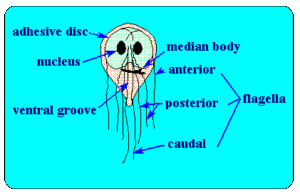Giardia
A Microbial Biorealm page on the genus Giardia

Classification
Higher order taxa:
Eukaryota; Diplomonadida group; Diplomonadida; Hexamitidae; Giardiinae; Giardia
Species:
Giardia lamblia, G. intestinalis
Description and Significance
Giardia was initially named Cercomonas intestinalis by Lambl in 1859 and renamed Giardia lamblia by Stiles in 1915, in honor of Professor A. Giard of Paris and Dr. F. Lambl of Prague. However, Giardia intestinalis is considered by many to be the correct name for this protozoan. Different species of Giardia are structurally very similar. It was customary to give each Giardia a different name when it was found in a new host, and thus Giardia in dogs was called Giardia canis; in cattle, Giardia bovis, and so on. Today scientists believe that only a few species occur, and each species can infect more than one host. However, more research is needed to identify each species and determine the hosts they can infect.
Giardia lamblia is the most commonly diagnosed intestinal parasite in public health laboratories in the United States, and is diagnosed by finding cysts or trophozoites in the feces of humans or animals (both of Giardia's life cycle stages have a characteristic appearance). The symptoms associated with giardiasis (also called "runner's diarrhea") range from none (in light infections) to severe, chronic diarrhea (in heavy infections), but not dysentery. Symptoms of giardiasis normally begin 1 to 2 weeks (average 7 days) after becoming infected. In otherwise healthy persons, symptoms of giardiasis may last 2 to 6 weeks, though occasionally symptoms last longer.
If one is diagnosed with this parasite, the drug of choice for the treatment of giardiasis is Metronidazole (Flagyl), but quinacrin hydrochloride and furazolidone are frequently used as well. However, drug resistance has been observed with each of these compounds. In addition, toxicity has restricted their use in women of child-bearing age and although less effective, furazolidone has been used preferentially for children since it can be administered as a suspension. Nevertheless, this compound has been recognized by the Food and Drug Administration (FDA) in the U.S. as both a mutagen and carcinogen and can no longer be used there. More recently a peptide antibiotic, bacitracin, stabilized with zinc, has been shown to have a high efficacy against Giardia infections. In recent clinical studies all patients responded well to this treatment with final cure rates of over 94%, and there were few side effects from this treatment.
As for the prevention of Giardia lamblia, it is known that boiling will kill Giardia cysts, and there are commercially available filters that will remove the cysts from water. Also, since Giardia is most common in daycares and in major camping grounds, when in those areas it is always a good idea to wash ones hands frequently and to take extra precaution to ensure that one's environment is sanitary.
Genome Structure
The Giardia lamblia (WB strain, clone C6) genome contains approximately 12 million base pairs distributed onto five chromosomes (chromosome polymorphism has been identified in different strains). Chromosome sizes range from 0.7 to over 3 Mb. The sequencing strategy was shotgun sequencing and DNA assembly was supported by comparison with a BAC-based physical map. The homepage for this study is Giardia DB.
Giardiavirus is a small, nonenveloped virus containing a monopartite double-stranded RNA genome, a major protein of 100 kDa, and a less abundant polypeptide of 190 kDa. It can be isolated from the culture supernatant of Giardia lamblia, a parasitic flagellate in human and other mammals, and efficiently infects other virus-free G. lamblia. A single-stranded copy of the viral RNA can be electroporated into uninfected G. lamblia cells to complete the viral replication cycle. Giardiavirus genomic cDNA of 6100 nt was constructed and its sequence revealed two large open reading frames that are separated by a -1 frameshift and share an overlap of 220 nt. The 3' open reading frame contains all consensus RNA-dependent RNA polymerase sequence motifs. A heptamer-pseudoknot structure much like those found at ribosomal slippage sites in retroviruses and yeast killer virus was identified within this overlap. Immunostudies using antisera against synthesized peptides from four regions in the two open reading frames indicated that the 100- and 190-kDa viral proteins share a common domain in the amino-terminal area. But the 190-kDa protein makes a -1 switch of its reading frame beyond the presumed slippage heptamer and is therefore a -1 frameshift fusion protein similar to the gag-pol fusion protein found in retroviruses (paraphrased from Wang reference, listed at bottom of page).
Cell Structure and Metabolism
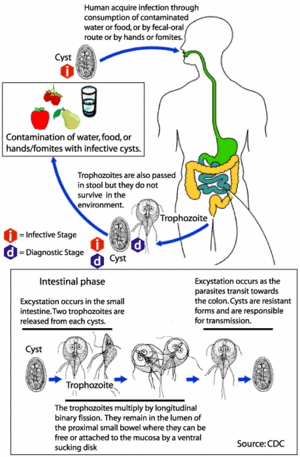
Giardia lamblia has a characteristic tear-drop shape and measures 10-15 µm in length. It has twin nuclei and an adhesive disk which is a rigid structure reinforced by supelicular microtubules. There are two median bodies of unknown function, but their shape is important for differentiating between species. There are 4 pairs of flagella, one anterior pair, two posterior pairs and a caudal pair. These organisms have no mitochondria, endoplasmic reticulum, golgi, or lysosomes.
Giardia has a two-stage life cycle consisting of trophozoite and cyst. The life cycle begins with ingested cysts, which release trophozoites (10-20 µm x 5-15 µm) in the duodenum. These trophozoites attach to the surface of the intestinal epithelium using a ventral sucking disk and then reproduce by binary fission. The trigger for encystment is unclear, but the process results in the inactive, environmentally resistant form of Giardia -- a cyst (11-14 µm x 7-10 µm) that is excreted in feces.
Giardia reproduce by binary fission and must be attached to a surface for this to occur.
Giardia's main food source, glucose, is obtained by a process of diffusion or by pinocytosis. Like amoebae, they are aerotolerant anaerobes and require a reducing environment. Food reserves are stored in the form of glycogen. Glucose catabolism via the glycolytic pathway results in production of the end products ethanol, acetate and carbon dioxide.
Ecology
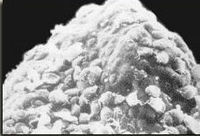
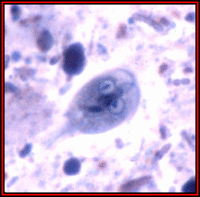
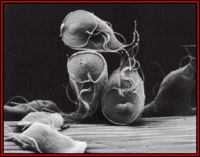
Giardia is found worldwide and infects humans as well as domestic and wild animals (e.g., cats, dogs, cattle, deer, and beavers). Giardia is found in soil, food, water, or surfaces that have been contaminated with the feces from infected humans or animals. One can become infected after accidentally swallowing the parasite, but one cannot become infected through contact with blood. Giardia lamblia does not invade the tissues of the small intestine, but instead adheres closely to the lining of the small intestine, and in heavy infections much of the lining of the small intestine can be covered with trophozoites (see image below from ThePetCenter.com). The parasites swim free and rapidly in a spiral motion in the intestinal lumen but also attach, via their adhesive disc, to the intestinal epithelium.
References
CDC Division of Parasitic Diseases. "Giardiasis Fact Sheet." Last updated: 17 Sept. 2004.
